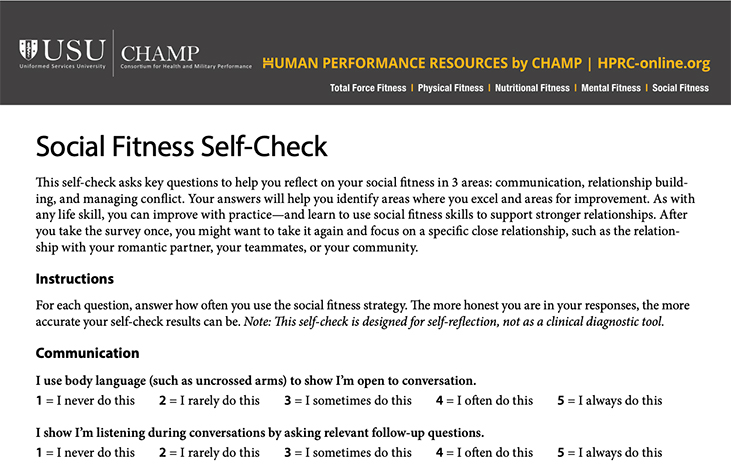Why should you assess your social fitness? Because the relationships you form with family, friends, teammates, and members of your community affect your health and ability to perform at your best. Learning more about your social fitness skill levels can help you strengthen any areas in need of improvement, which can in turn strengthen your relationships, health, and the readiness of your team. Take HPRC’s social fitness self-check below.
Published on: February 9, 2024
References
Allred, R. J., & Crowley, J. P. (2016). The “mere presence” hypothesis: Investigating the nonverbal effects of cell-phone presence on conversation satisfaction. Communication Studies, 68(1), 22–36. doi: 10.1080/10510974.2016.1241292
Altman, I., & Taylor, D. A. (1973). Social penetration: The development of interpersonal relationships. Holt, Rinehart & Winston.
Cafaro, A., Glas, N., & Pelachaud, C. (2016). The effects of interrupting behavior on interpersonal attitude and engagement in dyadic interactions. Paper presented at the AAMAS. doi: 10.5555/2936924.2937059
Dickens, L. R. (2017). Using gratitude to promote positive change: A series of meta-analyses investigating the effectiveness of gratitude interventions. Basic and Applied Social Psychology, 39(4), 193–208. doi: 10.1080/01973533.2017.1323638
Floyd, K. (2014). Empathic listening as an expression of interpersonal affection. International Journal of Listening, 28(1), 1–12. doi: 10.1080/10904018.2014.861293
Gottman, J. M., & Gottman, J. S. (2015). Gottman Couple Therapy. In A. S. Gurman, J. L. Lebow, & D. K. Snyder (Eds.), Clinical Handbook of Couple Therapy (5th ed., pp. 129–160). New York, NY: The Guilford Press.
Gottman, J. M., & Silver, N. (2015). The seven principles for making marriage work (2nd edition). New York: Harmony Books.
Heaney, C. A., & Israel, B. A. (2008). Social networks and social support. In K. Glanz, B. K. Rimer & K. Viswanath (Eds.), Health Behavior and Health Education: Theory, Research, and Practice (pp. 227–248). San Francisco, CA: Jossey-Bass.
Jug, R., Jiang, X. S., & Bean, S. M. (2019). Giving and receiving effective feedback: A review article and how-to guide. Archives of Pathology & Laboratory Medicine, 143(2), 244–250. doi: 10.5858/arpa.2018-0058-RA
McCarthy, R., Park, G. H., Barczak-Scarboro, N. E., Barrientos, S., Chamberlin, R., Hansom, A., & Messina, L. A. (2023). Social fitness and the social domain: A holistic approach based on Total Force Fitness. Journal of Special Operations Medicine. doi: 10.55460/trm7-423o
Metts, S. & Planalp, S. M. (2011). Nonverbal Signals. In M. L. Knapp, & J. A. Daly (Ed.), The Sage Handbook of Interpersonal Communication (4th ed.): Sage Publications.
Stafford, L. (2010). Measuring relationship maintenance behaviors: Critique and development of the revised relationship maintenance behavior scale. Journal of Social and Personal Relationships, 28(2), 278–303. doi: 10.1177/0265407510378125
Vanden Abeele, M. M., Hendrickson, A. T., Pollmann, M. M., & Ling, R. (2019). Phubbing behavior in conversations and its relation to perceived conversation intimacy and distraction: An exploratory observation study. Computers in Human Behavior, 100, 35–47. doi: 10.1016/j.chb.2019.06.004
